Exposure of Buffalo Milkers to Pathogenic Bacteria and Characterization of Isolated Methicillin-Resistant Staphylococcus spp.
Abstract
1. Introduction
2. Materials and Methods
2.1. General and Ethical Animal Care
2.2. Farms and Sampling
2.3. Raw Milk Samples Monitoring
2.3.1. Total Bacterial Count (TBC), E. coli, and Enterococci Analysis
2.3.2. Staphylococcus spp. and Staphylococcus Aureus Analysis
2.4. Surface Samples’ Microbiological Monitoring
2.5. Isolation and Molecular Characterization of Coagulase-Positive Staphylococcus spp. Colonies
2.6. Identification of Oxacillin/Methicillin-Resistant Staphylococcus spp. (MRSA) Strains
2.7. Statistical Analysis
3. Results and Discussion
3.1. Microbiological Analysis
3.2. Staphylococcus spp. identification and MRSA strains
4. Conclusions
Author Contributions
Funding
Institutional Review Board Statement
Informed Consent Statement
Data Availability Statement
Acknowledgments
Conflicts of Interest
References
- Alterisio, M.C.; Ciaramella, P.; Guccione, J. Dynamics of Macrophages and Polymorphonuclear Leukocytes Milk-Secreted by Buffaloes with Udders Characterized by Different Clinical Status. Vet. Sci. 2021, 8, 204. [Google Scholar] [CrossRef] [PubMed]
- Pisanu, S.; Cacciotto, C.; Pagnozzi, D.; Puggioni, G.M.G.; Uzzau, S.; Ciaramella, P.; Guccione, J.; Penati, M.; Pollera, C.; Moroni, P.; et al. Proteomic changes in the milk of water buffaloes (Bubalus bubalis) with subclinical mastitis due to intramammary infection by Staphylococcus aureus and by non-aureus staphylococci. Sci. Rep. 2019, 9, 15850. [Google Scholar] [CrossRef] [PubMed]
- Puggioni, G.M.G.; Tedde, V.; Uzzau, S.; Guccione, J.; Ciaramella, P.; Pollera, C.; Moroni, P.; Bronzo, V.; Addis, M.F. Evaluation of a bovine cathelicidin ELISA for detecting mastitis in the dairy buffalo: Comparison with milk somatic cell count and bacteriological culture. Res. Vet. Sci. 2020, 128, 129–134. [Google Scholar] [CrossRef] [PubMed]
- Anagrafe Nazionale Zootecnica (BDN)—Statistiche. Available online: https://www.vetinfo.it/j6_statistiche/#/report-pbi/1 (accessed on 16 December 2020).
- Guccione, J.; Ciaramella, P. Mastitis in Mediterranean Buffaloes. Dairy Vet. Sci. J. 2017, 2, 555596. [Google Scholar] [CrossRef]
- Guccione, J.; Borriello, G.; Ciaramella, P.; Di Loria, A. Clinical evaluation of poor milking procedures effects on dairy Mediterranean buffaloes udder health. Large Anim. Rev. 2017, 23, 155–157. [Google Scholar]
- Mota-Rojas, D.; De Rosa, G.; Mora-Medina, P.; Braghieri, A.; Guerrero-Legarreta, I.; Napolitano, F. Invited review: Dairy buffalo behaviour and welfare from calving to milking. CAB Rev. 2019, 14, 1–9. [Google Scholar] [CrossRef]
- Italian Parliament. Decreto Legislativo 9 Aprile 2008, n. 81 Attuazione Dell’articolo 1 della Legge 3 agosto 2007, n. 123, in Materia di Tutela Della Salute e Della Sicurezza nei Luoghi di Lavoro. (GU Serie Generale n.101 del 30-04-2008—Supplemento Ordinario n. 108). 2008. Available online: https://www.gazzettaufficiale.it/eli/id/2008/04/30/008G0104/sg (accessed on 12 June 2021).
- European Commission. Council Directive 89/391/EEC of 12 June 1989 on the Introduction of Measures to Encourage Improvements in the Safety and Health of Workers at Work. 1989. Available online: https://eur-lex.europa.eu/legal-content/EN/TXT/HTML/?uri=CELEX:31989L0391&from=EN (accessed on 2 January 2022).
- US Department of Labor Occupational Safety and Health Administration. OSH Act of 1970. Washington DC: US Department of Labor; 2013. 2004. Available online: https://www.osha.gov/laws-regs/oshact/completeoshact (accessed on 3 January 2022).
- Guccione, J.; D’Andrea, L.; Pesce, A.; Toni, F.; Borriello, G.; Salzano, C.; Diuccio, F.; Pascale, M.; Ciaramella, P. Antibiotic dry buffalo therapy: Effect of intramammary administration of benzathine cloxacillin against Staphylococcus aureus mastitis in dairy water buffalo. BMC Vet. Res. 2020, 16, 191. [Google Scholar] [CrossRef]
- Guccione, J.; Cosandey, A.; Pesce, A.; Di Loria, A.; Pascale, M.; Piantedosi, D.; Steiner, A.; Graber, H.U.; Ciaramella, P. Clinical outcomes and molecular genotyping of Staphylococcus aureus isolated from milk samples of dairy primiparous Mediterranean buffaloes (Bubalus bubalis). J. Dairy Sci. 2014, 97, 7606–7613. [Google Scholar] [CrossRef]
- Burzoni, S.; Duquenne, P.; Mater, G.; Ferrari, L. Workplace Biological Risk Assessment: Review of Existing and Description of a Comprehensive Approach. Atmosphere 2020, 11, 741. [Google Scholar] [CrossRef]
- De Carlo, E.; Mauriello, P.; Troiano, A. Sicurezza e Salute sul Lavoro nel Settore Bufalino; INAIL: Milano, Italy, 2017; Available online: https://www.testo-unico-sicurezza.com/_media/sicurezza-settore-bufalino.pdf (accessed on 2 April 2022).
- European Food Safety Authority. Assessment of Animal Diseases Caused by Bacteria Resistant to Antimicrobials: Cattle. EFSA Journal Published by John Wiley and Sons Ltd. On Behalf of European Food Safety Authority. 2021. Available online: https://www.efsa.europa.eu/sites/default/files/2021-11/9978.pdf (accessed on 11 June 2021).
- Guccione, J.; Pesce, A.; Pascale, M.; Salzano, C.; Tedeschi, G.; D’Andrea, L.; De Rosa, A.; Ciaramella, P. Efficacy of a polyvalent mastitis vaccine against Staphylococcus aureus on a dairy Mediterranean buffalo farm: Results of two clinical field trials. BMC Vet. Res. 2017, 13, 29. [Google Scholar] [CrossRef][Green Version]
- El-Ashker, M.; El-Gohary, F.; Hotzel, H. Staphylococci in cattle and buffaloes with mastitis in Dakahlia Governorate, Egypt. J. Dairy Sci. 2015, 98, 7450–7459. [Google Scholar] [CrossRef] [PubMed]
- World Health Organization. WHO Publishes List of Bacteria for Which New Antibiotics Are Urgently Needed. 2017. Available online: https://www.who.int/news-room/detail/27-02-2017 (accessed on 10 October 2021).
- Benedetti, V.; Cremonesi, P.; Ferrari, S.; Castiglioni, B.; Fabbi, M.; Vicari, N.; Garbarino, C.; Battisti, A.; Franco, A.; Feltrin, F.; et al. Staphylococcus aureus meticillino-resistenti (MRSA) da campioni di latte bovino. Large Anim. Rev. 2010, 16, 67–70. [Google Scholar]
- Antoci, E.; Pinzone, M.R.; Nunnari, G.; Stefani, S.; Cacopardo, B. Prevalence and molecular characteristics of methicillin-resistant Staphylococcus aureus (MRSA) among subjects working on bovine dairy farm. Infez. Med. 2013, 21, 125–129. [Google Scholar] [PubMed]
- Cuny, C.; Wieler, L.H.; Wolfgang, W. Livestock-associated MRSA: The impact on humans. Antibiotics 2015, 4, 521–543. [Google Scholar] [CrossRef]
- Mehndiratta, P.L.; Bhalla, P. Typing of Methicillin resistant Staphylococcus aureus: A technical review. Indian J. Med. Microbiol. 2012, 30, 16–23. [Google Scholar] [CrossRef]
- Lee, J.H. Methicillin (Oxacillin) resistant Staphylococcus aureus strains isolated from major food animals and their potential transmission to humans. Appl. Environ. Microbiol. 2003, 69, 6489–6494. [Google Scholar] [CrossRef]
- Guimarães, F.F.; Manzi, M.P.; Joaquim, S.F.; Richini-Fereira, V.B.; Langoni, H. Outbreak of methicillin-resistant Staphylococcus aureus (MRSA)-associated mastitis in a closed dairy herd. J. Dairy Sci. 2017, 100, 726–730. [Google Scholar] [CrossRef]
- Marshall, B.M.; Levy, S.B. Food animals and antimicrobials: Impacts on human health. Clin. Microbiol. Rev. 2011, 24, 718–733. [Google Scholar] [CrossRef]
- EMA, VICH GL9: Guideline on Good Clinical Practice. 2020. Available online: https://www.ema.europa.eu/en/vich-gl9-goodclinical-practices (accessed on 10 June 2021).
- ISO 4833-2:2013; Microbiology of the Food Chain—Horizontal Method for the Enumeration of Microorganisms—Part 2: Colony Count at 30 °C by the Surface Plating Technique. International Organization for Standardization: Geneva, Switzerland, 2013. Available online: https://www.iso.org/standard/59509.html (accessed on 7 July 2021).
- ISO 21528-2:2017; Microbiology of the Food Chain—Horizontal Method for the Detection and Enumeration of Enterobacteriaceae—Part 2: Colony-Count Technique. International Organization for Standardization: Geneva, Switzerland, 2017. Available online: https://www.iso.org/standard/63504.html (accessed on 7 July 2021).
- ISO 6888-1:2021; Microbiology of the Food Chain—Horizontal Method for the Enumeration of Coagulase-Positive Staphylococci (Staphylococcus aureus and Other Species)—Part 1: Method Using Baird-Parker Agar Medium. International Organization for Standardization: Geneva, Switzerland, 2021. Available online: https://www.iso.org/standard/76672.html (accessed on 7 July 2021).
- ISO 18593:2018; Microbiology of the Food Chain—Horizontal Methods for Surface Sampling. International Organization for Standardization: Geneva, Switzerland, 2018. Available online: https://www.iso.org/standard/64950.html (accessed on 7 July 2021).
- ISO 16649-2:2018; Microbiology of Food and Animal Feeding Stuffs—Horizontal Method for the Enumeration of Beta-Glucuronidase-Positive Escherichia coli—Part 2: Colony-Count Technique at 44 Degrees C Using 5-bromo-4-chloro-3-indolyl beta-D-glucuronide. International Organization for Standardization: Geneva, Switzerland, 2018. Available online: https://www.iso.org/standard/29824.html (accessed on 7 July 2021).
- Carraturo, F.; Del Giudice, C.; Compagnone, M.; Libralato, G.; Toscanesi, M.; Trifuoggi, M.; Galdiero, E.; Guida, M. Evaluation of microbial communities of bottled mineral waters and preliminary traceability analysis using NGS microbial fingerprints. Water 2021, 13, 2824. [Google Scholar] [CrossRef]
- Cofone, R.; Carraturo, F.; Capriello, T.; Libralato, G.; Siciliano, A.; Del Giudice, C.; Maio, N.; Guida, M.; Ferrandino, I. Eobania vermiculata as a potential indicator of nitrate contamination in soil. Ecotoxicol. Environ. Saf. 2020, 204, 111082. [Google Scholar] [CrossRef]
- Di Onofrio, V.; Maione, A.; Guida, M.; De Castro, O.; Liguori, R.; Carraturo, F.; Galdiero, E. Screening and isolation of microbes from a Mud Community of Ischia Island Thermal Springs: Preliminary analysis of a bioactive compound. J. Prev. Med. Hyg. 2021, 62, E479–E488. [Google Scholar] [CrossRef] [PubMed]
- Simor, A.E.; Goodfellow, J.; Louie, L.; Louie, M. Evaluation of a New Medium, Oxacillin Resistance Screening Agar Base, for the Detection of Methicillin-Resistant Staphylococcus aureus from Clinical Specimens. J. Clin. Microbiol. 2001, 39, 3422. [Google Scholar] [CrossRef] [PubMed][Green Version]
- Guccione, J.; Pesce, A.; Pascale, M.; Tommasini, N.; Garofalo, F.; Di Loria, A.; Cortese, L.; Salzano, C.; Ciaramella, P. Short communication: Effects of systemic treatment with penethamate hydriodide on udder health and milk yields in dry primiparous Mediterranean buffaloes (Bubalus bubalis). J. Dairy Sci. 2014, 97, 2219–2225. [Google Scholar] [CrossRef] [PubMed]
- European Parliament. Regulation (EC) No 853/2004 of the European Parliament and of the Council of 29 April 2004 Laying down Specific Hygiene Rules for Food of Animal Origin. 2004. Available online: http://data.europa.eu/eli/reg/2004/853/oj (accessed on 5 September 2021).
- Normanno, G.; Spinelli, E.; Caruso, M.; Fraccalvieri, R.; Capozzi, L.; Barlaam, A.; Parisi, A. Occurrence and characteristics of methicillin-resistant Staphylococcus aureus (MRSA) in buffalo bulk tank milk and the farm workers in Italy. Food Microbiol. 2020, 91, 103509. [Google Scholar] [CrossRef]
- Badua, A.T.; Boonyayatra, S.; Awaiwanont, N.; Gaban, P.B.V.; Mingala, C.N. Methicillin-resistant Staphylococcus aureus (MRSA) associated with mastitis among water buffaloes in the Philippines. Heliyon 2020, 6, e05663. [Google Scholar] [CrossRef] [PubMed]
- Wang, D.; Wang, Z.; Yan, Z.; Wu, J.; Ali, T.; Li, J.; Lv, Y.; Han, B. Bovine mastitis Staphylococcus aureus: Antibiotic susceptibility profile, resistance genes and molecular typing of methicillin-resistant and methicillin-sensitive strains in China. Infect. Genet. Evol. 2015, 31, 9–16. [Google Scholar] [CrossRef] [PubMed]
- Buyukcangaz, E.; Kahya, S.; Sen, A.; Intaş, K.S.; Eyigor, A.; Temelli, S.; Carli, K.T. MecA gene prevalence in Staphylococcus aureus isolates from dairy cows in Turkey. J. Biol. Environ. Sci. 2013, 7, 183–190. [Google Scholar]
- Nawar, S.; Rashid, M.T.; Ahmed, A.; Hossain, M.M.; Afzal, A.B. A Study of Prevalence and Pathogenic Activity of Bacteria in the Air of Dhaka City and Their Antimicrobial Resistance Pattern. Am. J. Mol. Biol. 2021, 11, 51–62. [Google Scholar] [CrossRef]
- Buommino, E.; Vollaro, A.; Nocera, F.P.; Lembo, F.; Della Greca, M.; De Martino, L.; Catania, M.R. Synergistic Effect of Abietic Acid with Oxacillin against Methicillin-Resistant Staphylococcus pseudintermedius. Antibiotics 2021, 10, 1258. [Google Scholar] [CrossRef]
- Bannoehr, J.; Guardabassi, L. Staphylococcus pseudintermedius in the dog: Taxonomy, diagnostics, ecology, epidemiology and pathogenicity. Vet. Dermatol. 2012, 23, 253.e52. [Google Scholar] [CrossRef]
- Pamuk, S.; Yildirim, Y.; Seker, E.; Gurler, Z.; Kara, R. A survey of the occurrence and properties of methicillin-resistant Staphylococcus aureus and methicillin-resistant Staphylococcus intermedius in water buffalo milk and dairy products in Turkey. Int. J. Dairy Technol. 2012, 65, 416–422. [Google Scholar] [CrossRef]
- de Almeida, C.C.; Pizauro, L.J.L.; Soltes, G.A.; Slavic, D.; de Ávila, F.A.; Pizauro, J.M.; MacInnes, J.I. Some coagulase negative Staphylococcus spp. isolated from buffalo can be misidentified as Staphylococcus aureus by phenotypic and Sa442 PCR methods. BMC Res. Notes 2018, 11, 346. [Google Scholar] [CrossRef] [PubMed]
- Pizauro, L.; de Almeida, C.; Gohari, I.; MacInnes, J.; Zafalon, L.; Kropinski, A.; Varani, A. Complete Genome Sequences of 11 Staphylococcus sp. Strains Isolated from Buffalo Milk and Milkers’ Hands. Microbiol. Resour. Announc. 2019, 8, e01264-19. [Google Scholar] [CrossRef] [PubMed]
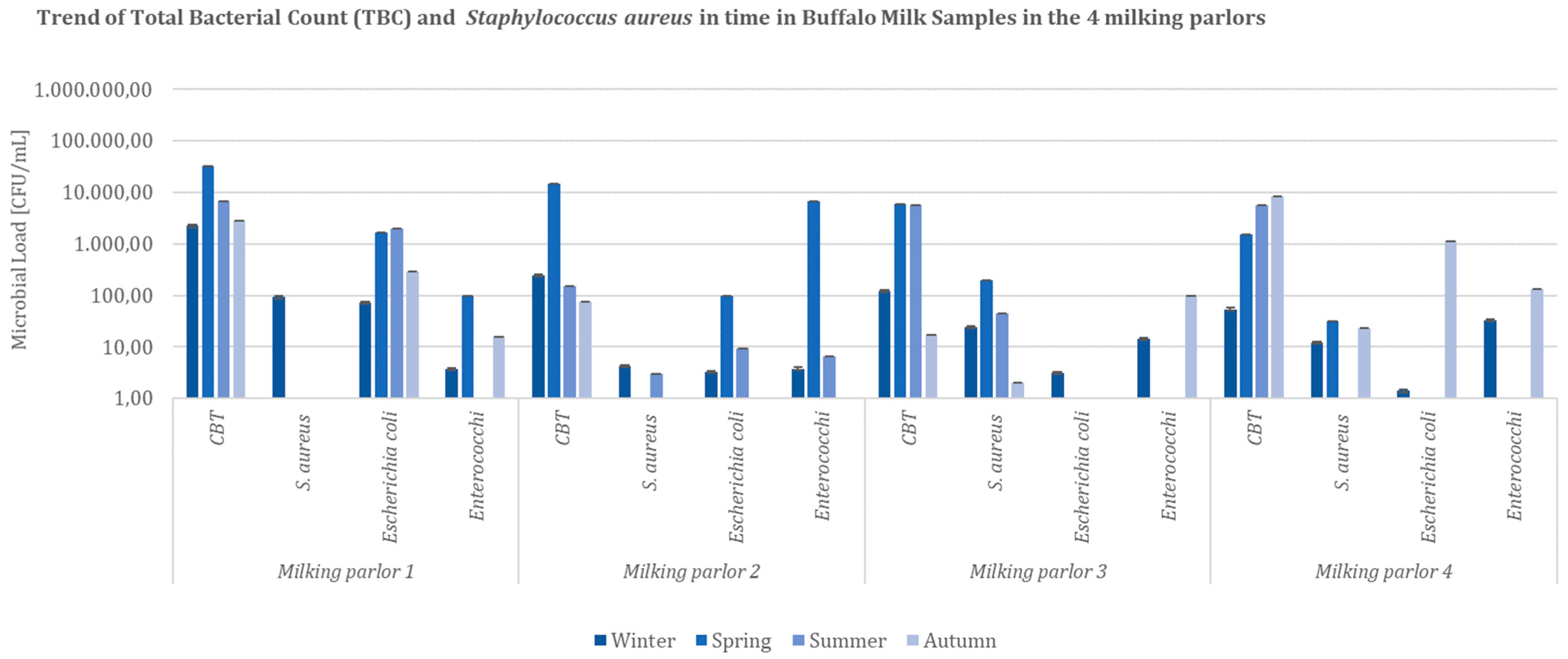
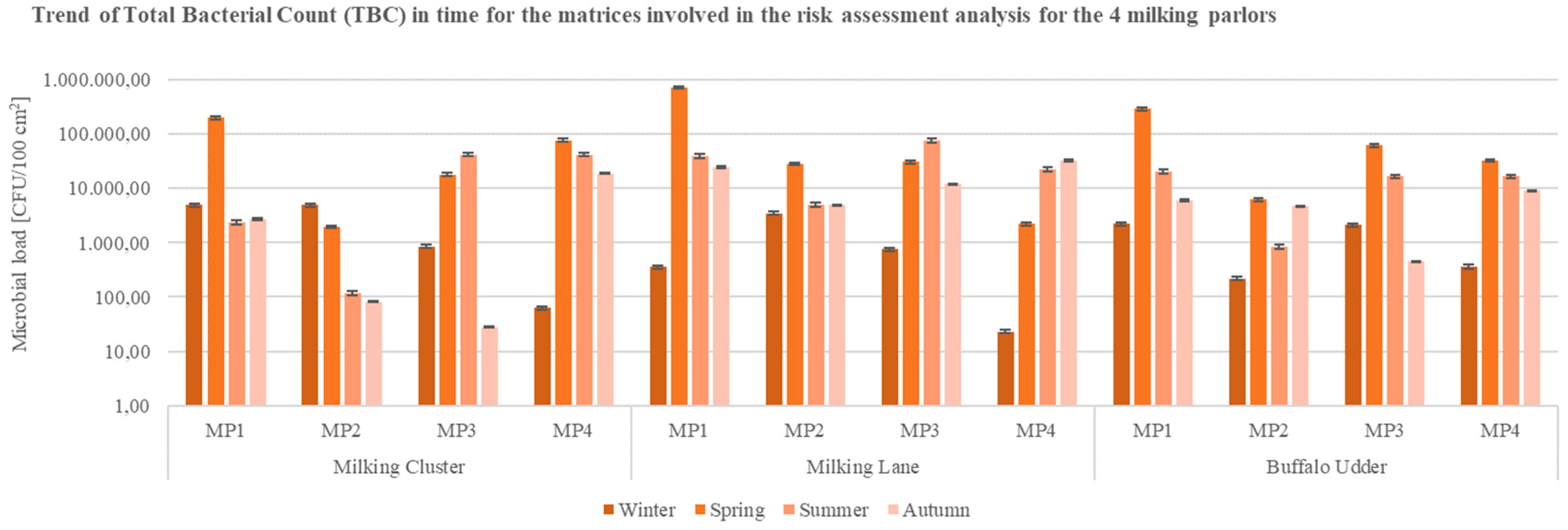

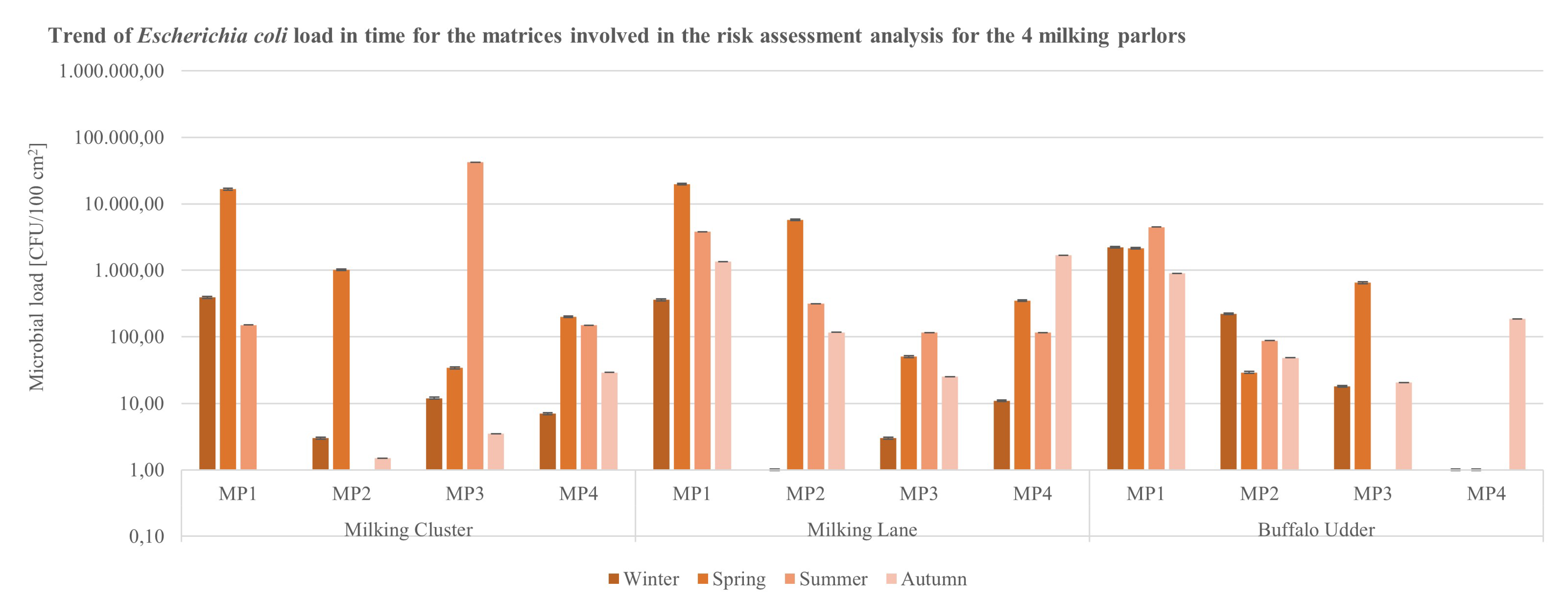
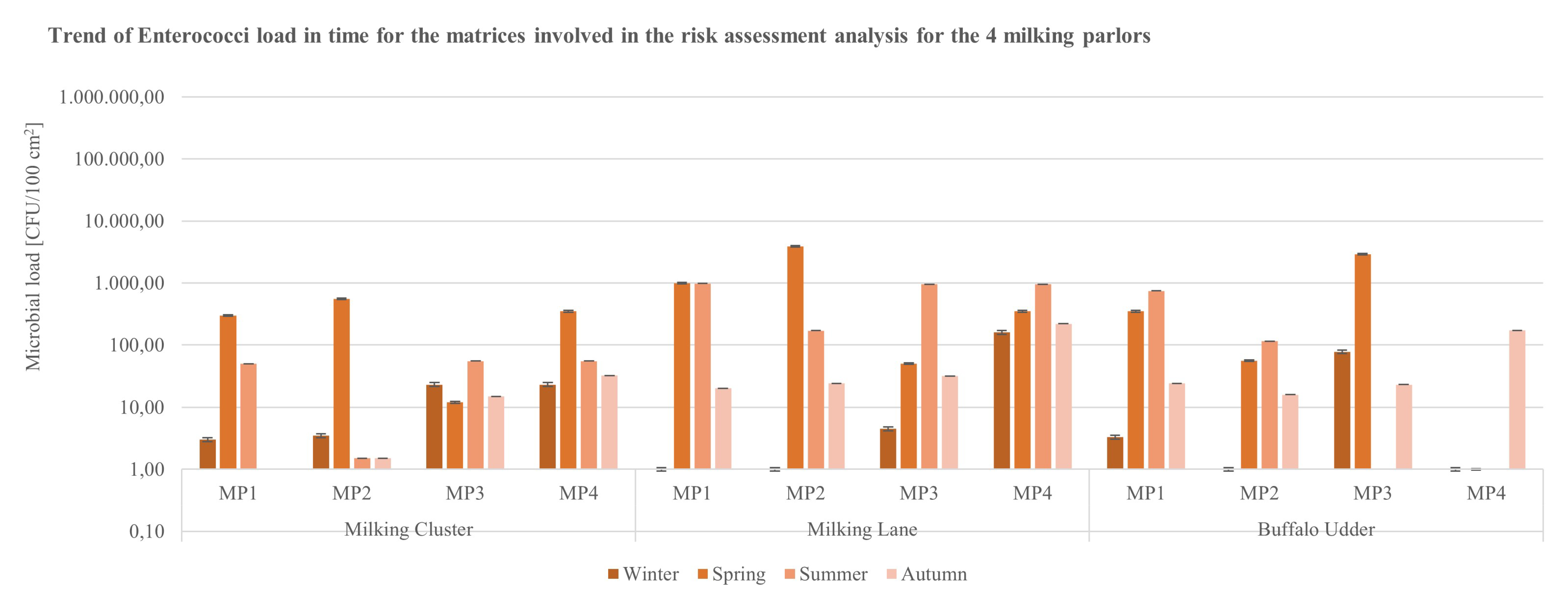
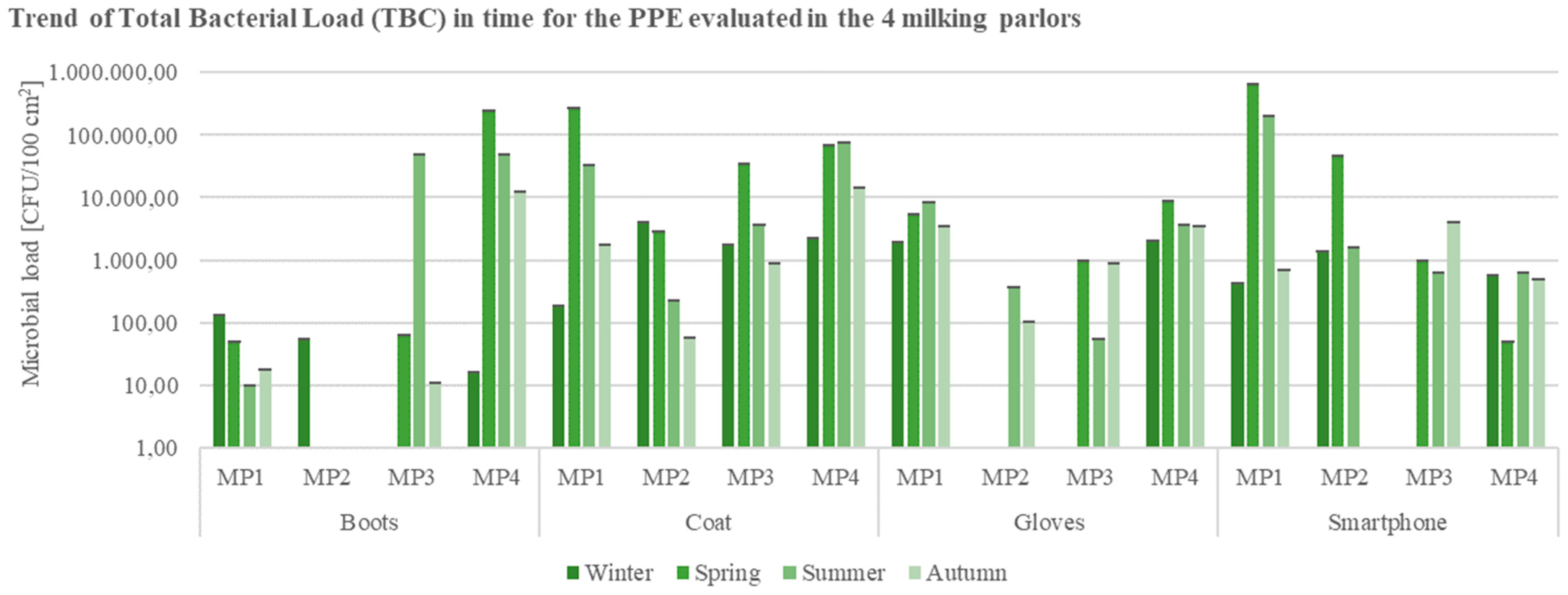
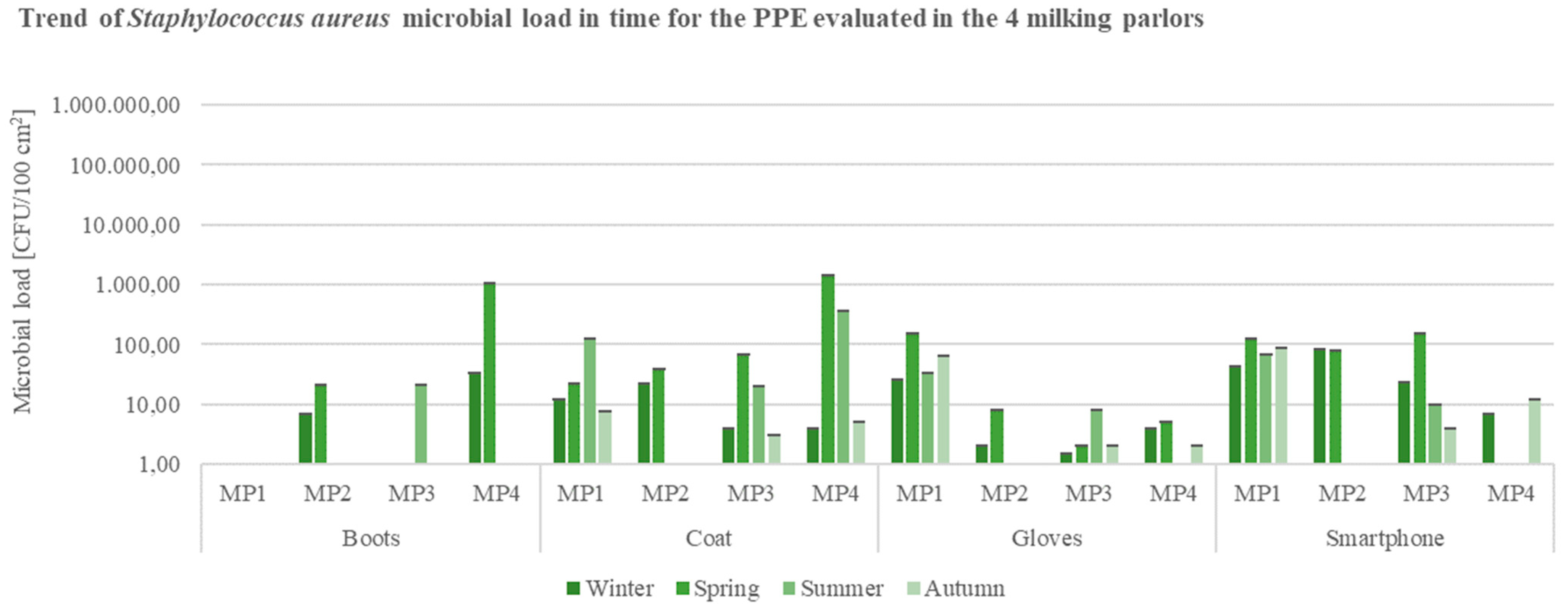
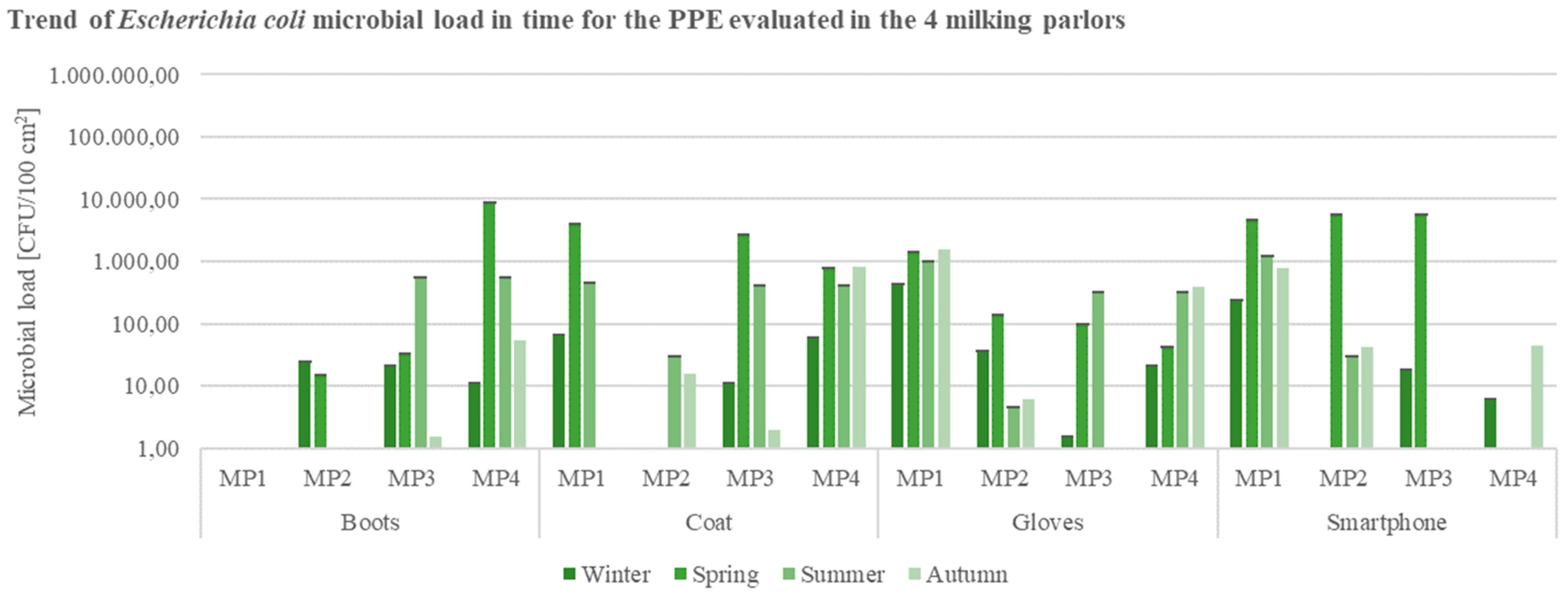
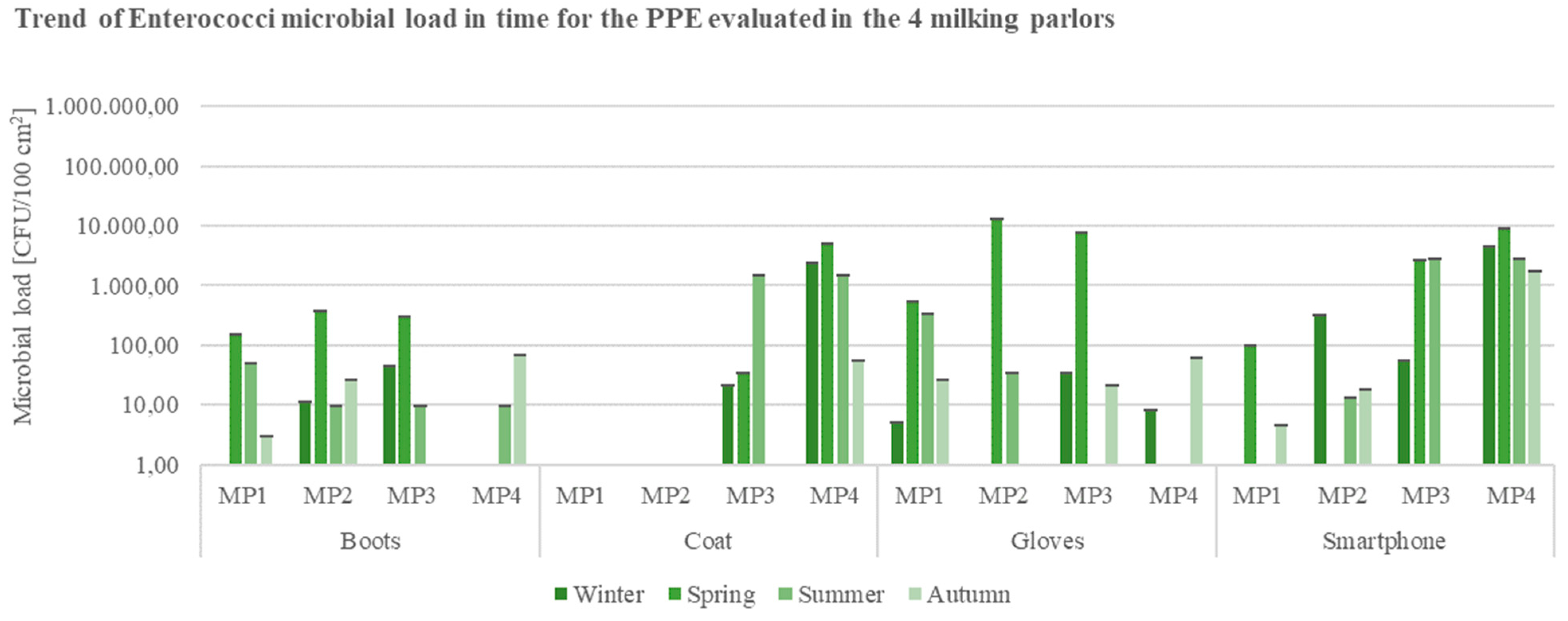
| Microorganism | Isolated from | Season | Max Score | Total Score | Query Cover | e-Value | % Identity | Accession n. | MRSA + |
|---|---|---|---|---|---|---|---|---|---|
| Staphylococcus aureus TPS3156 | Milk | Winter | 1.229 | 7.341 | 100% | 0.0 | 99.85% | AP023034.1 | |
| Staphylococcus epidermidis strain 3039 | Milk | Winter | 1.264 | 1.264 | 100% | 0.0 | 100.00% | MT613456.1 | |
| Staphylococcus aureus strain AF7 | Milk | Winter | 1.264 | 1.264 | 99% | 0.0 | 100.00% | MH645147.1 | X |
| Staphylococcus haemolyticus strain CPC | Milk | Winter | 1.254 | 1.254 | 99% | 0.0 | 100.00% | JX656750.1 | |
| Staphylococcus haemolyticus strain MTCC 29970 | Milk | Winter | 1.225 | 1.225 | 99% | 0.0 | 98.84% | MT569983.1 | |
| Staphylococcus sp. strain f50-6 | Milk | Winter | 1.267 | 1.267 | 100% | 0.0 | 99.86% | DQ837034.1 | |
| Staphylococcus aureus TPS3156 | Skin | Winter | 1.256 | 7.529 | 100% | 0.0 | 99.56% | AP023034.1 | |
| Staphylococcus pseudintermedius strain 157588 | Skin | Winter | 507 | 3.042 | 95% | 2.00 × 10−139 | 95.11% | CP054206.1 | X |
| Staphylococcus aureus strain cow | Skin | Winter | 1.277 | 1.277 | 100% | 0.0 | 99.57% | MT628394.1 | X |
| Staphylococcus jettensis strain SEQ256 | Skin | Winter | 1.249 | 1.249 | 100% | 0.0 | 99.14% | JN092114.2 | |
| Staphylococcus aureus strain cow | Skin | Summer | 1.277 | 1.277 | 98% | 0.0 | 99.43% | MT628394.1 | X |
| Staphylococcus muscae strain PCM 2406 | Milk | Spring | 944 | 944 | 96% | 0.0 | 96.99% | MF678949.1 | |
| Staphylococcus rostri strain DSM 21968 | Milk | Spring | 1.886 | 1.886 | 97% | 0.0 | 96.91% | MF678958.1 | |
| Staphylococcus aureus strain cow | Skin | Spring | 1.188 | 1.188 | 99% | 0.0 | 97.42% | MT628394.1 | X |
| Microorganism | Isolated from | Season | Max Score | Total Score | Query Cover | e-Value | % Identity | Accession n. | MRSA + |
|---|---|---|---|---|---|---|---|---|---|
| Staphylococcus chromogenes strain 34B | Milk | Winter | 1.286 | 7.657 | 99% | 0.0 | 99.44% | CP031470.1 | X |
| Staphylococcus aureus strain cow | Skin | Winter | 1.279 | 1.279 | 99% | 0.0 | 99.71% | MT628394.1 | |
| Staphylococcus aureus strain cow | Milk | Winter | 1.188 | 1.188 | 99% | 0.0 | 97.42% | MT628394.1 | X |
| Staphylococcus aureus strain cow | Skin | Spring | 1.293 | 1.293 | 99% | 0.0 | 99.72% | MT628394.1 | |
| Staphylococcus xylosus strain AL173 | Milk | Summer | 1.184 | 1.184 | 99% | 0.0 | 98.94% | MG819270.1 | |
| Staphylococcus aureus strain cow | Milk | Summer | 1.120 | 1.120 | 94% | 0.0 | 95.86% | MT628394.1 |
| Microorganism | Isolated from | Season | Max Score | Total Score | Query Cover | e-Value | % Identity | Accession n. | MRSA + |
|---|---|---|---|---|---|---|---|---|---|
| Staphylococcus sp. strain H-MRSA-155a | Milk | Winter | 1.146 | 1.146 | 96% | 0.0 | 96.84% | KT153203.1 | |
| Staphylococcus haemolyticus strain J-2-28 | Milk | Winter | 852 | 852 | 99% | 0.0 | 99.36% | MT312784.1 | X |
| Staphylococcus aureus strain 61.1.3 | Milk | Winter | 675 | 675 | 98% | 0.0 | 88.87% | KX454141.1 | X |
| Staphylococcus haemolyticus strain J-2-28 | Skin | Winter | 1.264 | 1.264 | 100% | 0.0 | 99.57% | MT312784.1 | |
| Staphylococcus aureus strain cow | Skin | Winter | 1.267 | 1.267 | 99% | 0.0 | 99.57% | MT628394.1 | |
| Staphylococcus aureus strain cow | Milk | Spring | 1.282 | 1.282 | 99% | 0.0 | 99.71% | MT628394.1 | |
| Staphylococcus aureus strain cow | Skin | Spring | 1.286 | 1.286 | 99% | 0.0 | 99.58% | MT628394.1 | |
| Staphylococcus chromogenes strain 34B | Milk | Spring | 1.282 | 7.635 | 99% | 0.0 | 99.71% | CP031470.1 |
| Microorganism | Isolated from | Season | Max Score | Total Score | Query Cover | e-Value | % Identity | Accession n. | MRSA + |
|---|---|---|---|---|---|---|---|---|---|
| Staphylococcus aureus strain MS1-4 | Milk | Winter | 1.271 | 1.271 | 99% | 0.0 | 99.15% | LC378383.1 | X |
| Staphylococcus aureus strain TPS3156 | Milk | Winter | 1.266 | 7.563 | 100% | 0.0 | 99.85% | AP023034.1 | X |
| Staphylococcus aureus strain 4726 | Milk | Winter | 1.247 | 1.247 | 100% | 0.0 | 99.14% | MN923027.1 | X |
| Staphylococcus hyicus strain PCM 2192 | Skin | Summer | 538 | 538 | 64% | 1.00 × 10148 | 93.72% | MF678941.1 |
| Milking Parlor | Isolated from | Staphylococcus aureus isolate | Winter | Spring | Summer | Autumn |
| MP1 | Buffalo Milk | Staphylococcus aureus strain TPS3156 | X | |||
| Staphylococcus aureus strain AF7 | X | |||||
| Buffalo Udder | Staphylococcus aureus strain cow | X | X | X | ||
| Staphylococcus aureus strain TPS3156 | X | |||||
| Milking Parlor | Isolated from | Staphylococcus aureus isolate | Winter | Spring | Summer | Autumn |
| MP2 | Buffalo Milk | Staphylococcus aureus strain cow | X | X | ||
| Buffalo Udder | Staphylococcus aureus strain cow | X | X | |||
| Milking Parlor | Isolated from | Staphylococcus aureus isolate | Winter | Spring | Summer | Autumn |
| MP3 | Buffalo Milk | Staphylococcus aureus strain 61.1.3 | X | |||
| Staphylococcus aureus strain cow | X | |||||
| Buffalo Skin | Staphylococcus aureus strain cow | X | X | |||
| Milking Parlor | Isolated from | Staphylococcus aureus isolate | Winter | Spring | Summer | Autumn |
| MP4 | Buffalo Milk | Staphylococcus aureus strain MS1-4 | X | |||
| Staphylococcus aureus strain TPS3156 | X | |||||
| Staphylococcus aureus strain 4726 | X |
Publisher’s Note: MDPI stays neutral with regard to jurisdictional claims in published maps and institutional affiliations. |
© 2022 by the authors. Licensee MDPI, Basel, Switzerland. This article is an open access article distributed under the terms and conditions of the Creative Commons Attribution (CC BY) license (https://creativecommons.org/licenses/by/4.0/).
Share and Cite
Carraturo, F.; Alterisio, M.C.; Guccione, J.; Cerullo, V.; Salamone, M.; Morelli, M.; Libralato, G.; Russo, E.; d’Angelo, R.; Ciaramella, P.; et al. Exposure of Buffalo Milkers to Pathogenic Bacteria and Characterization of Isolated Methicillin-Resistant Staphylococcus spp. Int. J. Environ. Res. Public Health 2022, 19, 4353. https://doi.org/10.3390/ijerph19074353
Carraturo F, Alterisio MC, Guccione J, Cerullo V, Salamone M, Morelli M, Libralato G, Russo E, d’Angelo R, Ciaramella P, et al. Exposure of Buffalo Milkers to Pathogenic Bacteria and Characterization of Isolated Methicillin-Resistant Staphylococcus spp. International Journal of Environmental Research and Public Health. 2022; 19(7):4353. https://doi.org/10.3390/ijerph19074353
Chicago/Turabian StyleCarraturo, Federica, Maria Chiara Alterisio, Jacopo Guccione, Valeria Cerullo, Michela Salamone, Michela Morelli, Giovanni Libralato, Ernesto Russo, Raffaele d’Angelo, Paolo Ciaramella, and et al. 2022. "Exposure of Buffalo Milkers to Pathogenic Bacteria and Characterization of Isolated Methicillin-Resistant Staphylococcus spp." International Journal of Environmental Research and Public Health 19, no. 7: 4353. https://doi.org/10.3390/ijerph19074353
APA StyleCarraturo, F., Alterisio, M. C., Guccione, J., Cerullo, V., Salamone, M., Morelli, M., Libralato, G., Russo, E., d’Angelo, R., Ciaramella, P., Di Loria, A., & Guida, M. (2022). Exposure of Buffalo Milkers to Pathogenic Bacteria and Characterization of Isolated Methicillin-Resistant Staphylococcus spp. International Journal of Environmental Research and Public Health, 19(7), 4353. https://doi.org/10.3390/ijerph19074353










